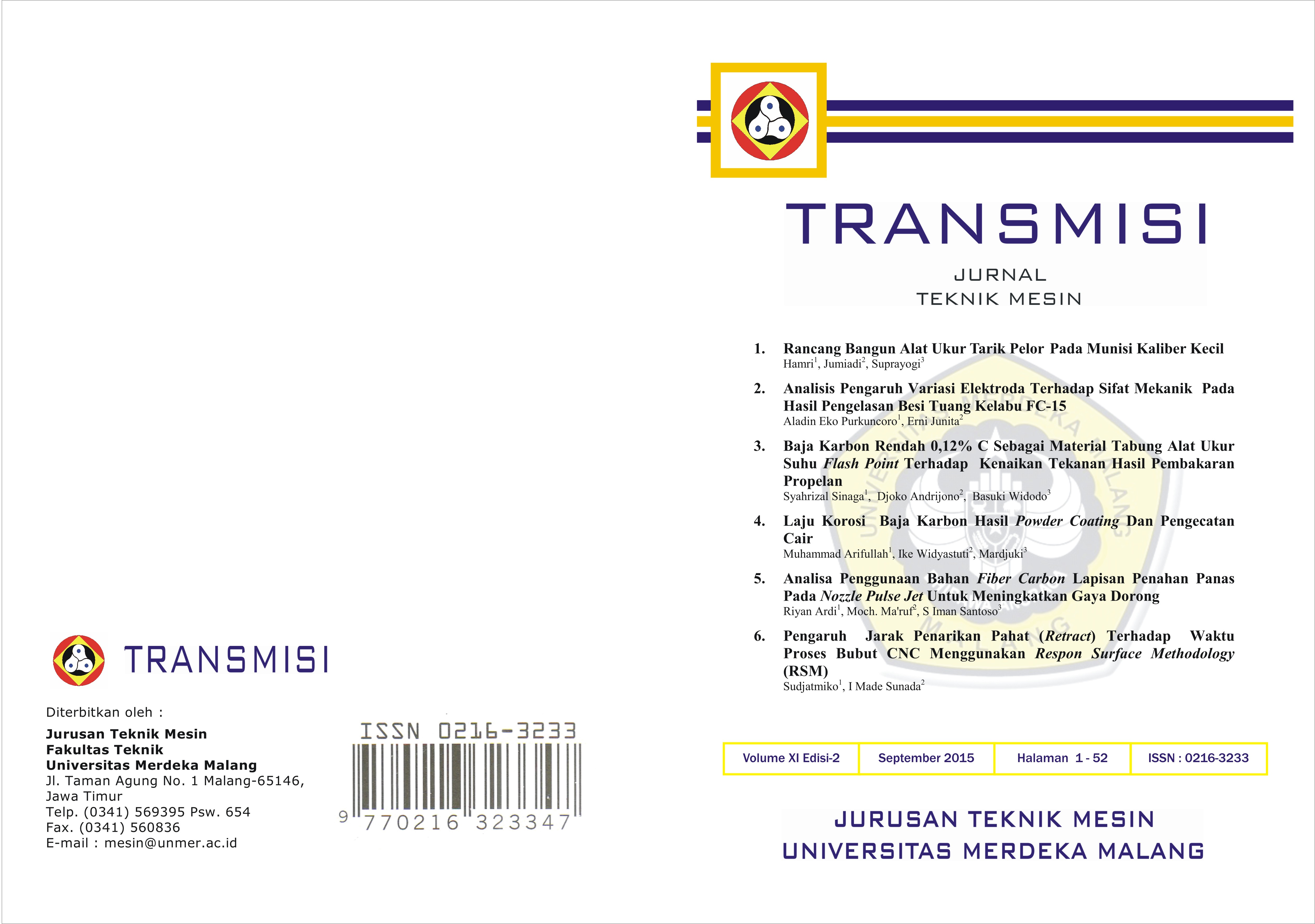PENGARUH JARAK PENARIKAN PAHAT (RETRACT) TERHADAP WAKTU PROSES BUBUT CNC MENGGUNAKAN RESPON SURFACE METHODOLOGY (RSM)
DOI:
https://doi.org/10.26905/jtmt.v11i2.4560Keywords:
Retract, Feed Cut Length, Rapid Transverse Length, Operation TimeAbstract
Penelitian ini menggunakan metode eksperimen faktorial, dimana cutting speed, feed rate, depth of cut, dan retract merupakan variabel bebas dari waktu proses pemesinan sebagai variabel responnya. Hasil yang di dapat dalam ekperimetal meliputi waktu proses pemesinan atau operation time, panjang langkah pemakanan atau feed cut length, dan panjang langkah tanpa pemakanan atau rapid transverse length. Data hasil eksperimen kemudian dilakukan analisis statistik ANOVA untuk melihat adanya pengaruh dan prosentase kontribusi dari masing- masing parameter terhadap waktu proses pemesinannya. Berdasarkan analisis statistik ANOVA diketahui bahwa ada pengaruh yang signifikan dari semua parameter terhadap waktu proses pemesinan CNC turning, dimana semakin besar nilai cutting speed, feed rate, dan depth of cut akan semakin singkat waktu proses pemesinanannya, sedangkan semakin kecil nilai retract akan semakin singkat waktu proses pemesinannya.Depth of cut memiliki kontibusi yang terbesar dengan nilai 71.78% (1 mm). Feed rate memiliki kontribusi terbesar kedua dengan nilai 23.88%. Retract memiliki kontribusi terbesar ketiga dengan nilai 1,99% (kondisi retract minimal = 1 mm). Waktu proses pemesinan yang dihasilkan pada kondisi tersebut adalah 7.57 menit Cutting speed memiliki kontribusi terendah dengan nilai 0.79%.Downloads
References
Anto Edi, 2013. Optimasi Parameter Pemesinan Terhadap Waktu Proses Pada Pemrograman CNC Turning. Skripsi Program Studi Pendidikan Teknik Mesin, Fakultaas Teknik, Universitas Negeri Semarang.
Boenasir. Wirawan Sumbodo. dan Karsono. 2010. Pembuatan Benda Kerja Menggunakan Mesin Bubut CNC Fanuc Series Oi Mate TC Berbasis Software AutoCAD, Jurnal Kompetensi Teknik. Vol. 2, No.1: 39-45.
Eduard Scharkus, Herman Jutz, 1966. Westermann Tables for the Metal Trade. 1976. New Delhi: Wiley Eastern Limited New Delhi Bangalore Bombay Calcutt (Revised to Indian Standar by SKIP).
Gurel, S. dan M.S. Akturk. 2007. Considering Manufacturing Cost and Scheduling Performance on a CNC Turning Machine. European Journal of Operational Research, Vol. 177: 325–343.
http://www.alumunium.org.otomotif, Dec 2010.
Murthy Madhav, K.Mallik harjuna Babu and R.Suresh Kumar, 2014. Optimization of Machinability Parameters of Al 6061 using Taguchi Technique, International Journal of Current Engineering and Technology ISSN 2277-4106.
Montgomery.D.C, 2001, Design and Analysis of Experiments. 5th edition, John Wiley & Son. Inc.
Pinar, Ahmet Murat. dan Abdulkadir Gullu. 2005. Time Minimization of CNC Part Programs in a Vertical Machining Center in Terms of Tool Path and Cutting Parameter Criteria. Turkish Journal of Engineering & Environmental Sciences. Vol. 29: 75-88.
Rochim, Taufiq, 2007, Teori dan Teknologi Proses Pemesinan. Laboratorium Teknik Produksi dan Metrologi Industri, Jurusan Teknik Mesin, FTI, ITB, Bandung.
Widarto. 2008. Teknik Pemesinan Untuk Sekolah Menengah Kejuruan, Jilid 1. Jakarta. Depdiknas.
Downloads
Published
Issue
Section
License

This work, is licensed under a Creative Commons Attribution-NonCommercial-NoDerivatives 4.0 International License.
Authors who publish with this journal agree to the following terms:
- Authors retain copyright and grant the journal right of first publication with the work simultaneously licensed under a Creative Commons Attribution-NonCommercial-NoDerivatives 4.0 International License. that allows others to share the work with an acknowledgment of the work's authorship and initial publication in this journal.
- Authors are able to enter into separate, additional contractual arrangements for the non-exclusive distribution of the journal's published version of the work (e.g., post it to an institutional repository or publish it in a book), with an acknowledgment of its initial publication in this journal.
- Authors are permitted and encouraged to post their work online (e.g., in institutional repositories or on their website) before and during the submission process, as it can lead to productive exchanges and earlier and greater citation of published work.




